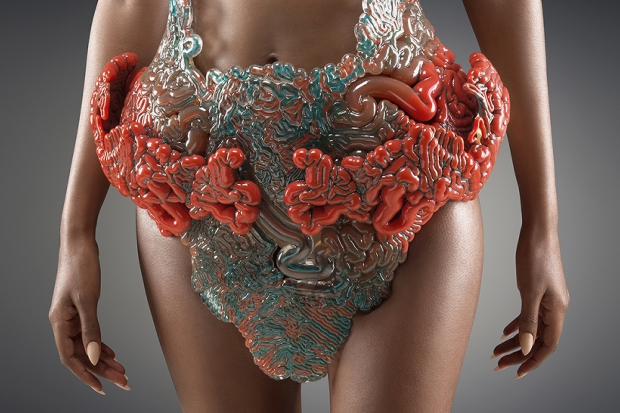
Neri Oxman is an architect, fashion designer, and associate professor at MIT Media Lab.
Her areas of application are architectural design, product design, and fashion design.
Her goal is to “augment the relationship between built, natural, and biological environments by employing design principles inspired and engineered by Nature, and implementing them in the invention of novel design technologies.”
Oxman’s inspirations are Picasso, Sontag, Beethoven, Bergman, Bernstein, Perriand, Virginia Woolf, Mies, Maureen Dowd, Maria Popova, as well as her sister and family. She’s also inspired by places like Walden Pond, Chauvet Cave, Atacama Desert, her grandmother’s garden, the Wailing Wall, Taliesin West, her childhood home, and any place where she can hear waves.

(Walden Pond, https://www.walden.org/property/walden-pond/walden-pond-2010-11-mitchell/)

(Atacama Desert, https://www.audleytravel.com/us/chile/places-to-go/the-atacama-desert)
She coined the term “material ecology” while she was studying her Ph. D. at MIT, defined as considering “computation, fabrication, and the material itself as inseparable dimensions of design. In this approach, products and buildings are biologically informed and digitally engineered by, with, and for, Nature.” I would say that she created this design movement as well as being apart of it.
Her projects are created using 3D printed technologies and a blend of synthetic and natural materials. Every project takes inspiration from biology and incorporates it into a fanciful yet technical design honoring the natural system in which we are alive and thriving, especially that which we cannot directly observe. Most often, Oxman and her team must design and create the means to make her projects happen. We will see in her piece Silk Pavilion that they needed to attach a 3D printing head to a robotic arm to alleviate the spatial constraints of a printing bed. In her Wanderers project, she needed “high resolution material modeling of macro-fluidic channels and the ability to print on them.” She has also created a way to 3D print glass reliably as opposed to the glass powder that was typical of 3D printers before. She also works frequently with E. Coli, describing it as “the workhorse of synthetic biology.” Other biological materials she and her lab frequently work with are slime molds and mushrooms. There are not limits to what biological organisms she integrates into her designs.
One of the 3D printers she uses for her projects is the Stratasys multi-material 3D printer. I’m not sure exactly what materials she uses to 3D print, she’s not too specific in her projects. Link to Stratasys and all the materials they offer to 3D print with: https://www.stratasys.com/materials/search
The most recent project in her portfolio that I find fascinating is a set called “Wanderers, An Astrobiological Exploration”
These are pieces that combine space exploration and genetically engineered microorganisms that she fantasized of a way to allow humans to travel to deadly, hostile environments that they would otherwise not survive. The wearables are designed to take some element out of a hostile environment and transform it into one of the elements needed for life, whether it’s photons or oxygen. It is also a project honoring the medieval Arabs who carefully studied and contributed to early astronomy and constellations.

Mushtari – Jupiter’s Wanderer
Engineered as a single long tube that contains cyanobacteria to take light and transform it into sucrose. It also functions as an independent gastrointestinal tract that performs all the functions that our own GI tract would. (http://www.materialecology.com/projects/details/mushtari.html)

Qamar – Luna’s Wanderer
A pneumatic surface area designed to generate and store oxygen. Inspired by the texture of the moon and contains spatial spherical pockets for algae-based air purification and biofuel collection. (http://www.materialecology.com/projects/details/al-qamar.html)

Zuhal – Saturn’s Wanderer
Covered with a dense hairy texture that is designed as a wearable vortex field to accommodate for the winds on Saturn. Titan, Saturn’s moon, includes hydrocarbons in its upper atmosphere as a possible precursor for life. Enceladus, Saturn’s other moon, has an ocean composition that has potential for microbial life. The hairy surface of this piece is designed to contain bacteria that can convert hydrocarbons to edible matter that can be safely consumed by humans. (http://www.materialecology.com/projects/details/zuhal.html#prettyPhoto)
OTHER WORK:


Silk Pavilion
“A dome created from silk fibres woven by a robotic arm, which was then finished by live silkworms.” The robotic arm had a 3D printer head mounted to it and wove the first parts of the silk to arrange a dome structure to be suspended from the ceiling. They then added 6500 silkworms to deposit their silk on the structure. Tiny magnets were attached to the silkworms for motion tracking data which was then used to program the robot arm to deposit the silk in a patterned way. The silkworms in a way become a biological printer. (https://www.dezeen.com/2013/06/03/silkworms-and-robot-work-together-to-weave-silk-pavilion/)
References:
http://www.materialecology.com/index.html (Portfolio)
https://www.media.mit.edu/posts/neri-oxman-on-architecture-femininity-feminism-and-breaking-down-barriers/ (Neri Oxman: On architecture, femininity, feminism, and breaking down barriers.)
https://www.dezeen.com/2013/06/03/silkworms-and-robot-work-together-to-weave-silk-pavilion/ (Silkworms and robot work together to weave Silk Pavilion)
https://www.nytimes.com/2018/10/06/style/neri-oxman-mit.html (Who is Neri Oxman?)
https://www.audleytravel.com/us/chile/places-to-go/the-atacama-desert
https://www.walden.org/property/walden-pond/walden-pond-2010-11-mitchell/